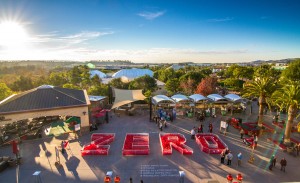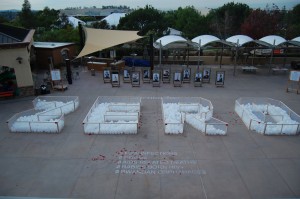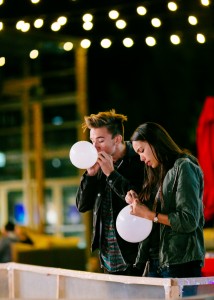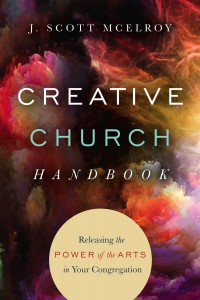 Welcome to the online extras and resources for Chapter 8: Building a Creative Congregation of The Creative Church Handbook. What you’ll find here is material that is helpful and important, but couldn’t be included in the book because of space constraints. Some thoughts include a reference to the specific page they would have appeared on.
Welcome to the online extras and resources for Chapter 8: Building a Creative Congregation of The Creative Church Handbook. What you’ll find here is material that is helpful and important, but couldn’t be included in the book because of space constraints. Some thoughts include a reference to the specific page they would have appeared on.
For information and discussion on similar topics see The New Renaissance Arts Movement site at TheNewR.org. For questions, comments, or use permissions you may contact the author directly at Scott (at) TheNewR.org.
Visit our CreativeChurchArtsIdeas.org website for more ideas for creativity and arts ministry in the local church!
The page is under construction. Please check back for updates!
Chapter 8: Building a Creative Congregation
- The ancients were commended for understanding that the physical world was created out of spiritual material—that what is seen was made not out of what was visible but out of what was invisible. The arts and creativity in our congregations help remind of that true.
- When the members of our congregations get a better handle on who they really are and what their calling might be, they will be primed to collaborate creatively with God in their daily live and step into that destiny. This can invigorate and even revolutionize their Christian walk.
- When we collaborate with the Holy Spirit, God can take us and our local churches to new levels of innovation and relevance. If we seek to partner with him, He will show us how to more truly represent his design and heart for people—to live freely, without fear, and open to his possibilities through faith.
- Ask your artists–especially as they become more adept as hearing God’s voice–to recount their experiences of collaborating with God in their work and to share it with their arts community and with the larger congregation. This will inspire and awaken faith in the hearers, whether they are artists or not.
Erwin McManus relates authenticity to art in this way,
“ There may be no virtue more admirable by those who understand themselves as artists than authenticity. Art finds its deepest value when it is the authentic expression of a deep human experience. Art becomes profound when it exposes us, explains us, or inspires us. We have all experienced artistic expressions that somehow left us flat and unmoved. We instinctively know when a film or a painting or a song is essentially soulless. Yet there is something breathtaking about a work that is genuinely original and authentic to the artist. We may not always have the language to explain it, but somehow we know the difference between art and imitation. And though we may be fooled form time to time, most of us quickly learn to distinguish between art and propaganda.”
Thoughts on collaborating with God through prayer:
Bill Johnson shared a great thought on collaborating with God and going beyond our comfort zone in prayer. He advises that our prayer lists should have at least three types of prayer points on them.
- We should pray for things that are probable because you align your heart with God and become a participant with what God is about to do.
- We should also have things on our list that are improbable. Not impossible, but improbable. For example a specific raise.
- Then the prayer list should include things that are totally impossible. This stretches us. But nothing is impossible with God. Live with the conviction that nothing is impossible. Stop being impressed with the size of a problem.
This builds our faith and expectancy for what God will do.
Thoughts on contributing creative talent to other ministries in the church:
Art of the Covenant at Menlo Park Presbyterian has offered creative support to Sunday school classes, workshops, women’s

work together to fabricate an art piece
under the guidance of professional
artist Catherine Kapikian.
groups, and with sermon series, but they strike a balance between giving back to the church and protecting their artist’s time and talents. They don’t want to be the place to go for free art, because that can get out of hand. Sometimes when they do a project for a service there is a budget that will also compensate the artists.
Another function of arts ministry is to help return the arts and creativity to the “amateurs”:
Arts ministry in churches returns the power of the arts and creativity to the average person, not just the very talented. Luann Jennings observes that, “Many arts organizations, leaders, and advocates are realizing just what a giant mistake we made when we professionalized the arts and limited non-professionals’ participation to just watching us do it. Granted, there were always some contexts in which professionals operated – you don’t want an amateur architect or engineer building a cathedral – but there were many other contexts in which ama-teurs (amare = “to love”) were welcomed to create until relatively recently. Doug Borwick, author of Building Communities, Not Audiences, says ‘It is from community that the arts developed and it is in serving communities that the arts will thrive…. Communities do not exist to serve the arts; the arts exist to serve communities.’
More ways to stimulate creativity in the congregation:
Here are a few other ideas that stimulate creativity in children and could work for congregations, as well:
• Expose them to other cultures.
• Show them how to look at things from a different perspective.
• Have them role play.
• Ask them to come up with solutions to problems.
• Encourage them to play (and create) nicely with others.
• Encourage them to be open to doing things a different way.
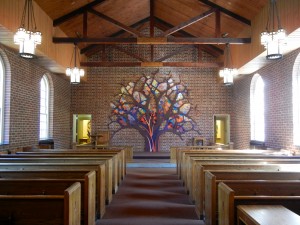
Catherine Kapikian.
More effects of the arts on congregations:
Kate Frank is the director of women’s ministries at Vineyard Boise. At a recent Faith and Fellowship event, the office bookkeeper of church volunteered to set up an art project for the 50 women at the Saturday morning event. She provided 2 inch canvases and collage material and invited everyone to assemble a piece expressing how God is relating to them through their hardship .
Kate told Jessie Nilo afterward, “As a church we have come such a long way in embracing creativity and just having it be part of the fabric of who we are together. When Karen brought out the painting project, she set us up by being vulnerable herself in telling her story, but when it came time for the exercise, not one person out of 50 said, I can’t do it. Not one! I just take it now as a matter of course, but look how far we’ve come. I don’t know that that would’ve happened before the arts were brought into the culture of our church.”
The arts can also help us slow down and look at our situations and our lives in a new way, or from a different angle. To contemplate, to dare to dream that God would love to work with us to bring creative solutions to life’s everyday matters. To train ourselves to be more observant of what is going on around us and how God is in it.
Photos of the Ex Creatis Saddleback Church Zero Aids day installation:
Ex Creatis arts initiative at Saddleback Church often has interactive art available outside of the sanctuary as a way of responding to what has been said during a message. On World AIDS Day weekend, Saddleback church attendees were invited to participate in a response piece symbolizing the global Getting to Zero initiative. Five thousand red balloons filled a giant installation that spelled “Zero.”Individuals were invited to pop a balloon, symbolizing that they would make an impact in fighting HIV and AIDS. They would then replace the red balloons with new white balloons that were inside the deflated red ones. This
represented hope. Five thousand red balloons were popped and five thousand white balloons
were blown up by five thousand different participants. They learned that “getting to zero” is a large task, but by coming together as a single working unit, they can do big things.
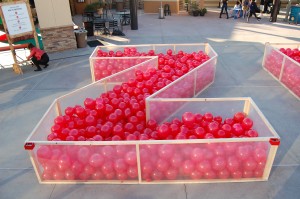
built giant letters to spell “Zero” and
filled them with red balloons for their
aid eradication Getting to Zero
campaign. Photo: Eric Cardella.
